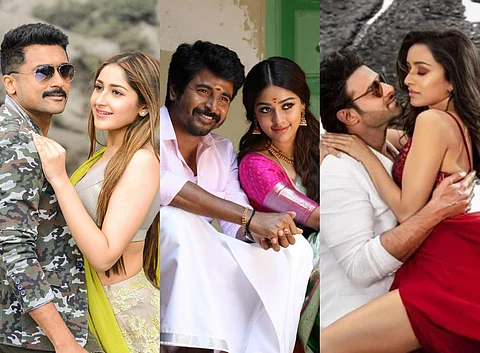

They say what we do says a lot about who we are. It can be argued that a person’s profession would affect perceptions of their character and consequently, their demeanour. It is not just tangible details that a job fills a person with, but also imperceptible ones. For example, as a journalist, anything and everything is a potential story idea for me, similar to how a photographer would keep looking for a frame, even in the unlikeliest of places. You might wonder why I am talking about this. The reason is that three of our biggest releases recently -- Saaho, Kaappaan, and Namma Veettu Pillai -- have, in a sense, the same female lead.
Let me explain. On paper, you can’t find three more different women. Saaho’s Amritha Nair (Shraddha Kapoor) is a police officer, one who is part of investigating high-profile theft. Kaappaan’s Anjali (Sayyeshaa) is the Prime Minister’s press secretary and Namma Veettu Pillai’s Maangani (Anu Emmanuel), is an IAS-aspirant. Different backgrounds, different milieus. Mysteriously though, how they exist and function in these stories is annoyingly similar. The sole purpose of the three women is to exist as objects of romantic interest for the male leads. Thus no matter what they are told to be, the actual characteristics and the template don’t really change.
Amritha might be on a mission but is mostly present so that Saaho can throw lovelorn gazes at her (with that godawful Thithithara Thithithai in the background). Amritha and Saaho go undercover in a pub in the trail of a suspect. What we get is a dance number with Amritha in a shimmery dress, drunk beyond control, proving to be a ‘distraction’ to the hero. Guess where else this same scene finds a place? In Kaappaan, which released days after Saaho. Anjali mistakes Kathir (Suriya) to be a terrorist, follows him to a pub. Kathir is on a mission himself, to track the actual criminal. The situation leads to Kathir and Anjali sharing a drink and guess who becomes uncontrollably drunk and has to be taken care of by the hero? A small difference is that here, other women dance in skimpy clothes to a Tamil song (the pub is in London, by the way).
At least, Amritha and Anjali are shown to be doing something remotely related to their careers, even if they are inexplicably bad at it. Maangani, on the other hand, doesn’t have even one scene showing her to be preparing for her civil service exams. Exasperatingly, all she seems to want to talk about is what girls seek from their romantic partners. The entire ‘IAS dream’ is made to be a running gag. Just like how Amritha's cop job or Anjali's secretary job is made a joke out of.
The trend isn't exactly new. Earlier it was common for women to not harbour career aspirations, even when they are employed. Pioneered by K Balachander, the 70s saw the struggling woman who worked so that she can save her family, not because she wanted to. The 80s was filled with predominantly students (ones who return home after studying elsewhere, to be precise) and homemakers, inhabiting story scapes. Not that much thought or effort were put into it. It didn't really matter what they were studying. The student syndrome continued well into the 2000s, where they were interspersed with working women. Of course, there are exceptions, but the core occupations of the women characters never deviated from being mere romantic pursuits. Remember Malliga from Aegan? Or more recently, Aishwarya in Kalakalappu 2 (Nikki Galrani), a Tahsildar whose wardrobe predominantly consists of sleeveless blouses and translucent sarees?
The argument here isn't that professional excellence is the only attribute of a well-defined woman character, or that all female characters should be seen excelling at their work. After all, Neelambari, one of the most iconic women characters, isn't shown to have a profession. This piece is more of an afterthought as to why we don’t see more women pursuing normal careers. And also when you give them a job, why not show them realistically, instead of making it a clip-on detail to an already existing template?
I still see 2019 as a hopeful year just because more women are shown to be having jobs on screen. And a few interesting ones too, ones that go beyond the journalists and teachers. Thadam had a movie reviewer; 90 ML had Oviyaa play a tattoo artist. Boomerang had Megha Akash essay an aspiring female filmmaker. Mr. Local had Nayanthara head a television production house, Comali had Kajal play the curator of an art gallery. The more conventional jobs found mentions as well. 100 had Hansika work at a BPO and A1 had Tara Alisha Berry as a high-paying tech employee, while Kanne Kalaimaane saw Tamannaah play a bank manager. So while we are getting more consistent with showing women have jobs, let’s allow them to work a bit as well?